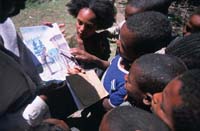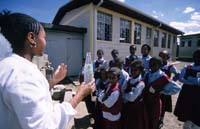14.2.1 Conducting training sessions
During a training session, you should undertake the following activities:
- Start with introductions and/or an icebreaker activity. Welcome participants and introduce yourself by name to them. Talk briefly about why the training is important, and what your interest is in the training. Allow all the participants to introduce themselves. Adult learners appreciate an open, comfortable learning environment. Motivate participants at the beginning of a training session by introducing a fun activity (known as an ‘icebreaker’) that requires them to interact and learn more about each other (Figure 14.4). Do not spend too much time on these ‘icebreaker’ activities (recommended time is about 10 minutes).
 Figure 14.4 Community groups of all ages will require special health training in order to be able to tackle health issues (Photo: WaterAid/Caroline Irby)
Figure 14.4 Community groups of all ages will require special health training in order to be able to tackle health issues (Photo: WaterAid/Caroline Irby) - Describe the agenda. Explain to participants what training areas will be covered by the training, the order you will present topics, and how much time you will be spending on each one. Ask if they will need to modify or create their own agendas, according to their needs, culture, or customs.
- Gauge participants’ knowledge and interest. Before you start training, it is advisable to assess the participants’ level of knowledge and interests. To do so, you should ask participants to complete some questions prepared for this purpose — or you can do this orally by asking the participants. Allow about 10–15 minutes to complete this task. This enables you to adapt the training activities to the knowledge, skills, interests and culture of the training participants. As you start presenting each topic in turn, take a few minutes to find out how much participants know about the topic, and what areas they would like to focus on.
- Pay attention to participants. Do the participants look as though they are following the session well? Are they nodding, volunteering comments, and asking questions? Stop from time to time to ask for questions and ask how everyone is doing. If participants are tired or unengaged, you may need to slow down, turn the material into questions and generate discussion. Or it may be necessary to move more quickly, switch to a different type of activity, or take a short break. You can also revitalise their energy with a brief fun activity (either physical or not) that gets learning moving again.
- Be flexible. Some things may not go as you planned. Be aware that some of your activities may take longer or shorter than planned. Explain to participants what is going on if you need to deviate from the schedule you have laid out. If participants do not seem to be engaged in a given activity, be prepared to adjust, stretch, shrink or eliminate activities as necessary.
- Think about keeping the interest of participants. Keep the interest of participants. Start with simple concepts; build them into more complex ideas. Integrate physical movement, humour and practical demonstrations (Figure 14.5). Tailor the presentation or talk to the specific group of participants. Include and encourage personal stories and humour whenever possible.
- Conclusion. End each session with a summary, and a chance for participants to share their last thoughts. Ask everyone to share one thing that really stood out from the session.
- Evaluate each session. This enables you to find out what worked in your session. Ask participants to give you feedback, so you can find out what they learnt in your session, what they enjoyed most, and what they would change.

Have you ever received training? Do you have any comments on the way it was conducted? As you read the previous section about elements of a training session, think back to whether and when, as a trainee you have experienced these various elements. Was your experience good, bad or indifferent?
Most people can remember some training that they have received in the past. You can probably remember both good and bad points from the training that will help you plan your training sessions in the community. Some people have been to sessions where the icebreakers were boring or made people anxious. On other occasions, icebreakers have been a good way of getting to know the participants and helping everyone to feel relaxed. Remember that if you have had an unsatisfactory experience of a particular training activity, it just means that the person leading the activity did not have enough experience or understanding of how people learn. The training as a whole may have been good overall. Following steps 1–8 above should help you to make your training sessions work well for the participants.
14.2 Training
